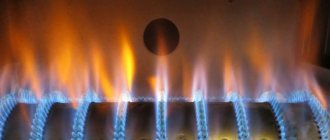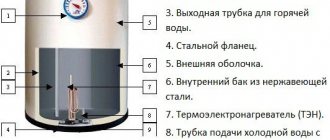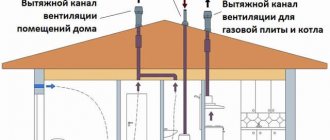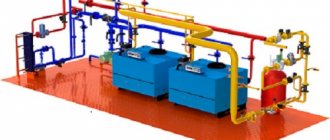
The gas column ignition unit in working order prevents emergencies, ensures that the main burner is triggered when the hot water tap is opened and the flame dies out after it is closed. There are several types of columns, classified by the type of ignition, differing in the internal structure and principle of operation.
Geysers with piezo ignition
The main difference between piezoelectric ignition and flow-through boilers with manual ignition is that the pilot burner is ignited by means of a piezoelectric element built into the structure. Despite the popularity of automatic dispensers, domestic and foreign manufacturers still produce gas flowing water heaters with piezo ignition and a constantly operating ignition burner.
The principle of operation is in many ways similar to that used in columns, where the burner is ignited from matches. There are common structural elements, the same breakdowns are encountered.
Piezo ignition device
The design contains a permanently working ignition wick. To turn on the column, you need to light the igniter. For ignition, a piezoelectric element is present in the structure, consisting of a power button connected to a spark electrode connected to the burner device. When the button is pressed, a spark is produced, hitting the burner, igniting the gas.
The principle of operation of a piezoelectric element is associated with the conversion of mechanical and kinetic energy into electrical energy. When pressed, a spark is generated strong enough to ignite the burner. Piezo ignition for a gas column often fails. After 3-4 years, you will need to change the unit and adjust it.
How to replace the piezoelectric element
Symptoms of malfunction: weak spark, ignition after a large number of keystrokes on the element (normally it works with 1-2 clicks).
First, you should try to repair the piezo ignition. It happens that a malfunction is caused by breakdowns in the current-carrying cable. Disconnect the speaker case to see the cause of the problem. After that, they press the piezo ignition button several times and follow where the spark is directed.
There is a gas spring in the feed pipe of the ignition burner. An additional function is to receive a spark from a piezo. The spring should be bent towards the electrode.
If the changes did not help, there is no spark, when changing the location of the electrodes, the situation does not change, the piezoelectric element of the gas column should be replaced. The key can be easily removed. Depending on the model, the housing holds a lock nut or several bolts. The wire from the electrode is folded back by removing the terminal. Works with certain skills take 10-15 minutes of time.
Principle of operation
The action of the piezoelectric element is most clearly seen on the example of a push-action lighter. When you press the button, the lighter gives out a whole series of sparks, which indicates the most successful use of the piezoelectric generator in this design. To imagine the principle of operation, it is recommended to consider a diagram of a simplified model of this device. It is made in the form of a support with a lever that creates a large force acting on the piezoelectric element.


The elements themselves are solid cylindrical structures with electrodes at the ends. They are in contact with each other, so they are affected by the same force. The orientation of each piezoelectric element between each other is made in such a way that the electrodes of the contacting surfaces have one charge, for example, positive, and the opposite ends have a charge with a different sign.The connection procedure must be followed, especially when making such a device with your own hands.
Under the action of the lever, the electrodes are closed, and there is an electrical parallel connection of each piezoelectric element to each other. A current lead with a rounded tip located at a certain distance from the metal base is brought out from the point of contact. As you press the lever, an electrical spark breaks through the air gap between the base and the tip. Now it is already clear how such a lighter works. With further pressure, the force increases, which leads to the appearance of a second and subsequent sparks. This will continue until the piezoelectric elements are completely destroyed.
Electric ignition for gas water heater
Present in fully automatic boilers. The principle of operation of a continuous gas water heater with electric ignition eliminates the need for a constantly burning wick. The main burner ignites immediately. The source of electricity is a 220 W household network, batteries or a built-in hydrogenerator.
Automatic electronic ignition of the geyser occurs when the hot water supply tap is opened. After closing the DHW point, the burner goes out automatically.
Battery ignition
The device of the electronic unit for the ignition of gas water heaters is used in fully automatic water heaters. In the factory configuration, batteries are used as batteries.
Electronic ignition of a gas water heater works as follows:
- the rod in the water reducer has special legs connected to the electric ignition;
- when DHW is turned on, the membrane presses on the stem, opens the gas valve and at the same time gives a signal to generate a spark;
- after ignition of the flame, the battery-powered spark generation unit is switched off.
Battery power has one major drawback. Replacement of elements is required every six months. If desired, you can install an adapter and connect the speaker to a household power supply through it. This solution will eliminate the need for constant and frequent battery replacement.
Ignition from a hydrogenerator
In the columns of the new generation, the batteries have been replaced with a turbine. Geysers with a hydrogenerator are switched on due to the production of electric current through the conversion of mechanical energy.
The water heater works in a completely autonomous mode, but has several disadvantages:
- sensitivity to pressure and water quality;
- dependence of uninterrupted operation on regular maintenance.
A spark from a hydrodynamic generator is produced only when the water pressure is sufficiently high. At a pressure of 0.3-0.5 atm. the automatic column from the batteries turns on normally, and the water heater with a turbine simply does not start. To ensure the stable operation of the device with hydrodynamic ignition, it is necessary to use a booster pump and a water treatment system that includes several degrees of purification.
Ignition of a smokeless gas water heater
An important component of a gas water heater is the column ignition system. This element affects not only the usability of the device, but also the degree of its safety.
Three types of ignition can be installed in non-flue gas water heaters:
- Electronic;
- Piezo ignition;
- Ignition from a hydraulic turbine.
Devices equipped with an electronic ignition system have one important feature - they do not have to be in standby mode all the time. When it is necessary to ignite the device, a spark is created, the energy for which is taken from the batteries. Ignition is carried out every time the tap is opened, and the rest of the time the system is inactive.


Piezo ignition works due to the piezoelectric effect, i.e. the applied mechanical force creates a spark.Unlike the previous design, piezoelectric ignition requires a constantly burning igniter, which ensures the operation of the water heater.
What is a column flame ionization sensor
- ionization electrode;
- photosensor.
The principle of operation is based on the fact that in the process of combustion in gas columns, flame ionization or the production of ion current is created. The amount of energy is directly proportional to the intensity of combustion. Incorrect ratio of the gas-air mixture, settling of dust, damping of the main burner will trigger the sensor. By blocking the gas supply, gas leakage is prevented if the burner spontaneously extinguishes.
How to properly light the column
The ignition is carried out as follows:
- the gas supply button is clamped;
- after 10-15 seconds, the piezoelement key is pressed or a burning match is brought up (depending on the type of ignition);
- the wick ignites;
- after another 20 seconds, the gas supply button is released.
The gas water heater with electric ignition turns on independently when you open the hot water tap. Switching on should be silent. Pops, long operation of the spark generator unit indicates a malfunction.
The gas column ignition unit in working order prevents emergencies, ensures that the main burner is triggered when the hot water tap is opened and the flame dies out after it is closed. There are several types of columns, classified by the type of ignition, differing in the internal structure and principle of operation.
Structural elements of the gas column
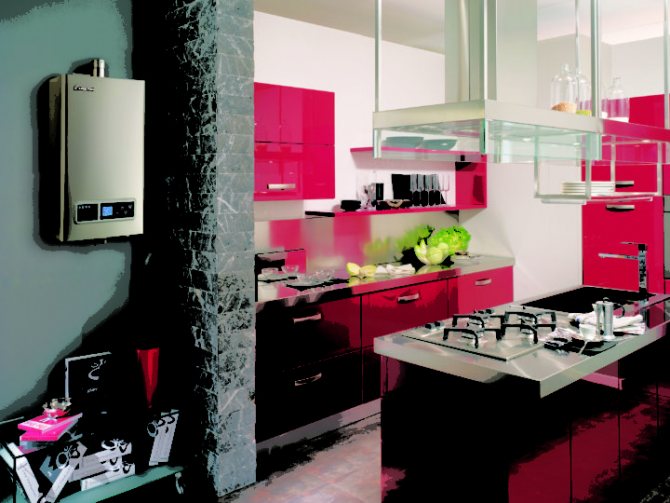

Gas water heater in the interior
The considered heating device contains (or may contain - it depends on the type and model) such constituent elements:
- heat exchanger
- gas unit with gas burners (ignition and main), gas connection
- power and flow regulators
- chimney connection system
- exhaust hood
- draft sensor (it turns off the system if there is no draft and combustion products cannot be removed)
- column igniter
- on / off switch
- back panel
- diaphragm valve
- water node
- ignition system (piezo or electronic), including an ignition electrode (depending on the design)
- safety valve
- metal case
Column in action
2 pipes for water are connected to the column: through the first of them, cold water enters the apparatus, and through the second, already heated warm or hot water comes out and 1 pipe for supplying gas, on which the column operates.
The structure may contain or, conversely, be absent some elements, without which its normal operation is impossible. It all depends on the type of each specific device.
Electric ignition for gas water heater
Present in fully automatic boilers. The principle of operation of a continuous gas water heater with electric ignition eliminates the need for a constantly burning wick. The main burner ignites immediately. The source of electricity is a 220 W household network, batteries or a built-in hydrogenerator.
Automatic electronic ignition of the geyser occurs when the hot water supply tap is opened. After closing the DHW point, the burner goes out automatically.
Battery ignition
The device of the electronic unit for the ignition of gas water heaters is used in fully automatic water heaters. In the factory configuration, batteries are used as batteries.
Electronic ignition of a gas water heater works as follows:
- the rod in the water reducer has special legs connected to the electric ignition;
- when DHW is turned on, the membrane presses on the stem, opens the gas valve and at the same time gives a signal to generate a spark;
- after ignition of the flame, the battery-powered spark generation unit is switched off.
Battery power has one major drawback. Replacement of elements is required every six months. If desired, you can install an adapter and connect the speaker to a household power supply through it. This solution will eliminate the need for constant and frequent battery replacement.
Ignition from a hydrogenerator
In the columns of the new generation, the batteries have been replaced with a turbine. Geysers with a hydrogenerator are switched on due to the production of electric current through the conversion of mechanical energy.
The water heater works in a completely autonomous mode, but has several disadvantages:
- sensitivity to pressure and water quality;
- dependence of uninterrupted operation on regular maintenance.
A spark from a hydrodynamic generator is produced only when the water pressure is sufficiently high. At a pressure of 0.3-0.5 atm. the automatic column from the batteries turns on normally, and the water heater with a turbine simply does not start. To ensure the stable operation of the device with hydrodynamic ignition, it is necessary to use a booster pump and a water treatment system that includes several degrees of purification.
What is a column flame ionization sensor
- ionization electrode;
- photosensor.
The principle of operation is based on the fact that in the process of combustion in gas columns, flame ionization or the production of ion current is created. The amount of energy is directly proportional to the intensity of combustion. Incorrect ratio of the gas-air mixture, settling of dust, damping of the main burner will trigger the sensor. By blocking the gas supply, gas leakage is prevented if the burner spontaneously extinguishes.
How to properly light the column
The ignition is carried out as follows:
- the gas supply button is clamped;
- after 10-15 seconds, the piezoelement key is pressed or a burning match is brought up (depending on the type of ignition);
- the wick ignites;
- after another 20 seconds, the gas supply button is released.
The gas water heater with electric ignition turns on independently when you open the hot water tap. Switching on should be silent. Pops, long operation of the spark generator unit indicates a malfunction.
If there is no hot water supply in your house, or if you constantly turn off hot water, then life becomes completely uncomfortable. But that's not a reason to give up a warm shower on a cool autumn evening, right? This problem can be solved by installing a gas column, as many users do. But how does such a miniature water heater work and can it cope with its task?
We will talk about all this in detail in our publication - here we consider the principle of operation of the gas column, the diagrams of its device. It also focuses on the main equipment malfunctions and ways to cope with them. The presented material is supplemented with visual illustrations, diagrams and videos.
How does the ignition take place?
To turn on the column, you need to open the gas in the gas burner and ignite it. Depending on the type of unit, the ignition process can be very different:
- If the simplest way of ignition is used in the column - manual, the fuel of the column, that is, gas, is ignited by turning the gas valve located on the front of the device and bringing a burning match to the place of its exit.
- Piezo ignition is considered more convenient and modern, which is carried out by applying mechanical forces, due to which a spark is struck that ignites the igniter and the supplied gas. To start turning on, in this case, you must press the button on the front panel. When the wick lights up in this way, it is enough to open the hot water tap - and the column, having switched to operating mode, will begin to heat the water passing through it.
- The third ignition option is the most progressive - electric ignition.The principle of operation of a battery-powered gas water heater is considered the most reliable, because in order to turn on such a column, you do not need to independently open gas taps and set fire to matches. The spark is charged in this case by batteries.
Ignition is an important indicator in the operation of a gas column. Depending on the selected type of ignition, the way of switching on one or another column, as well as its cost, changes.
The general structure of the household column
The geyser is a flow-through water heater. This means that the water passes through it and heats up along the way. But, before proceeding to the analysis of how a household gas water heater is arranged for heating water, we recall that its installation and replacement are associated with a centralized gas supply system.
Therefore, it is imperative to submit documents to the gas service of your region along with the corresponding application. You can read about the norms and necessary documents in our other articles, and now let's move on to the device.
Various models of gas water heaters differ among themselves, but the general structure of a household gas water heater looks like this:
- Gas-burner.
- Igniter / ignition system.
- Exhaust hood and chimney connection.
- Chimney pipe.
- The combustion chamber.
- Fan (on some models).
- Heat exchanger.
- Gas supply branch pipe.
- Water node.
- Water inlet nozzles.
- Hot water outlet.
- Front panel with controller.
The central element of the column is gas-burner, in which the combustion of gas is maintained, which contributes to the heating of the water. The burner is installed in the body, it collects hot combustion products, the purpose of which is to heat water.
How does a gas water heater work?
Let's get acquainted with the principle of operation of a gas column in the form of a simple algorithm:
- when water flows through the water assembly, the membrane strains and moves up the stem connected to the gas valve;
- then the valve opens the gas supply to the main burner;
- gas is ignited from an electrode or igniter, burns out and heats up the water that flows through the pipes of the heat exchanger;
- the heated water flow is supplied to the tap through the left branch pipe;
- gas combustion products are removed through the chimney or exhaust hood - there is a fundamental difference between open and closed columns, which will be described in detail below.
At the same time, the power of the flame and the power of the water flow through the column can be adjusted using the controls on the front panel.
And now let's take a closer look at how the burner is ignited and how the already mentioned water unit is connected with this.
Gas ignition method
In general, gas water heaters are based on three methods of gas ignition. As can be seen in the diagram, in all three cases the reaction of the water unit (frog) serves as a signal to ignite the main burner.
There are three ignition methods:
- using a piezoelectric element;
- from batteries;
- from the rotation of the hydraulic turbine.
Ignition with piezoelectric element - this is a manual ignition, and assumes the presence of a button on the front panel. Pressing the button causes the piezoelectric element to close, which ignites the igniter. He, in turn, ignites the main burner after a signal from the rod, which is moved by the water membrane with an active water pressure.
The igniter continues to burn with a small flame until it is manually turned off. This leads to increased gas consumption and increased scale formation in the pipes. One of the gas instantaneous water heaters with manual ignition is Bosch Therm 4000 O W 10-2 P.
Geysers of some models work on batteries... In this case, ignition occurs from an electric spark after the signal from the rod. Thus, instead of an igniter, electrodes are present here, which directly ignite the main gas burner.
But the batteries need to be changed on average once every 10 months, and with constant use - once every 2 months, so that there are no unforeseen circumstances. One such battery-powered speaker is the Zanussi GWH 10 Fonte Glass La Spezia.
Sometimes ignition occurs from rotation hydro turbines (with water flow). Ignition also occurs from an electric spark, but the batteries do not need to be changed, because the turbine itself generates electricity in the process of flowing water.
But for the operation of the hydraulic turbine, a high pressure in the pipes is required, at least 0.3 bar. Not every home has this kind of pressure. In Russia and other CIS countries, it is not advised to buy such columns due to the unstable water pressure. An example of such a model is the Bosch Therm 6000 O WRD 15-2 G gas water heater, which is noticeably more expensive than the above two models.
Column water assembly device
The device of the water unit is of particular interest. Its structure can be seen in the diagram below, detail captions are below the diagram. The rest of the designated elements are used for fasteners.
The main working details are stock and diaphragm, under the influence of which it moves when the flow of water begins in the lower part. The stem opens the valve and allows gas to flow into the burner, which is then ignited.
Another work item is pvc ball, which serves as a fuse. It shuts off the gas flow during sudden pressure drops in water pipes - hydraulic shocks, which we will also talk about later.
Combustion chamber type
According to the design of combustion chambers, there are two types of gas columns: open and closed.
Columns with open combustion chamber have open air access to the burner, and the combustion products go into the hood.
Such models are simpler than turbocharged ones, which will be discussed below, their operation is almost silent and in most cases they do not require electricity. However, due to the open connection between the combustion chamber and the room, air pollution in the room is possible if the hood works poorly.
Columns with closed combustion chamber are turbocharged. The combustion chamber in them is hermetically sealed, in addition to the channels for air injection and outlet. It is pumped there by a fan through coaxial pipes and goes outside through the chimney, together with the combustion products.
Such columns are usually fully automated, they do not have manual controls, and the thrust and temperature sensors in them are more sensitive. These speakers are “modern” and more secure.
The illustrations above showed a gas column with a closed combustion chamber. For comparison, in the following illustration, you can see the arrangement of two types of speakers side by side. You will find many similar elements with them, but the principle of removing combustion products is noticeably different.
findings
For the uninitiated into the basics of electromechanics, it is better not to go into the jungle of diagrams and descriptions, it is enough to know that when the gas is turned on, simultaneous ignition occurs and an open fire is obtained, on which you can cook any food. For the safe operation of the product, it is necessary to strictly follow the manufacturer's recommendations prescribed in the attached instructions.
This question is asked by the buyer when choosing a gas hob or stove. After all, the difference in price between equipment with gas control and without it is palpable. We will not touch upon all the technical subtleties of this system, but will try to talk about its advantages and disadvantages.
In all built-in gas ovens and in ovens of GEFEST gas stoves, the presence of a gas control system is mandatory, because gas enters a confined space. And if, for some reason, the flame fizzles out, the gas will accumulate, and when exposed to it with a spark, there is a possibility of an explosion. If, when water or milk boils off, the fire on the burner goes out, the system will automatically turn off the gas.Gas control of desktop burners is an additional function, its presence or absence is not regulated by GOST, and the manufacturer installs this system in the equipment at its discretion.
Convenience of turning on the burner (if the ignition is built into the tap handle).
It is not uncommon for gas control of table burners to be combined with electric ignition built into the tap control knob. This option creates convenience when turning on a gas burner. You just need to turn the tap handle counterclockwise and press it a little and hold it. In this case, one hand remains free and there is no need to press a separate electric ignition button. In almost all GEFEST stoves, the gas control system is combined with such ignition (in the tap handle).
The presence of additional, complex elements in the gas control system of table burners leads to a significant increase in the cost of such equipment.
Maintenance and repair costs.
The same factor also affects the cost of post-warranty repairs for your money. If we talk about the gas control system of table burners, then a special valve is installed on each, with an electromagnetic valve, a separate thermocouple. If the system is combined with an electric ignition built into the handle, then a button control unit is used. Within two years, any breakdown (within the warranty case) will be repaired free of charge.
Not convenient to turn on the burner.
And this is not a typo. If the advantages indicated the inclusion combined with electric ignition integrated (built-in) into the handle of the tap, then this moment was not included in the disadvantages for nothing. The fact is that when you press the tap handle, it must be held in this position for 3 to 5 seconds. Sounds simple, but in real life it is not fast. One two three four five. At this time, you do not release the handle and do not go about your business, but stand near the stove and wait for the flame to fix.
Do not turn on the burner if the gas control is faulty.
This point is perhaps the most significant in favor of technology without a gas burner control system, since at least one faulty unit of the system will not be able to turn on the gas burner, even if you use matches, the flame will go out.
If the gas stove is used by an elderly person who forgets to turn off the boiling kettle in time, or you have small curious children who strive to twist the control knobs of the gas taps, or you are just a person who wants to protect yourself in the event of a gas leak, then gas control stoves are yours. option and you can not do without it.
If all of the above does not bind you, then do not waste time thinking and buy an ordinary stove without gas control of the table burners. After all, our grandmothers and parents lived without it, and we will also live without problems.
Key features of the speakers
Now let's talk about the aspects of the practical use of the column. One of the main characteristics - performance... It directly correlates with the power, which is indicated in kW and shows the volume of water heated by 25 ° C per minute.
The characteristics are usually indicated in the passport of the device. An ordinary column heats 10-20 liters of water at 25 ° C per minute, although this value can fluctuate significantly.
Another characteristic of modern speakers is power modulation... It shows how the column power can change depending on the water flow and is measured as a percentage of the initial power.
For modulation, the columns are equipped with special fittings with a membrane, which changes the gas supply to the burner depending on the flow. Modulation is considered normal in the range of 40-100% of the device's power.
Safety sensors and their meaning
A gas water heater can be dangerous, because it is connected simultaneously with the water and gas mains, each of which, individually, can pose a threat.
In case of problems with the gas or water supply, safety sensors turn off the column, and special valves will shut off the water or gas supply.
Usually, gas water heaters can withstand a voltage of up to 10-12 bar, which is 20-50 times higher than the usual pressure in pipes. Such sudden jumps are possible with the so-called water hammer.
But if the pressure is lower than 0.1-0.2 bar, then the column will not be able to work. You need to carefully study the instructions and characteristics before buying in order to understand whether the column is optimized for low water pressure in the pipes of the CIS countries and whether it will work properly. And vice versa - will it withstand sudden pressure drops, which, alas, is also not uncommon in our conditions.
In general, a modern gas water heater contains many safety sensors. All of them, in case of breakdown, can be replaced.
More details about the purpose and location of the sensors are in the table below.
| Sensor name | Location and purpose of the sensor |
| Chimney draft sensor | Located at the top of the device, connecting the column to the chimney. Turns off the column in the absence of draft in the chimney |
| Gas valve | Located in the gas supply pipe. Turns off the column when the gas pressure drops |
| Ionization sensor | Located in the camera of the device. Turns off the device if the flame goes out when the gas is on. |
| Flame detector | Located in the camera of the device. Shuts off the gas if the flame does not appear after ignition |
| Relief valve | Located on the water inlet. Turns off water at elevated pressure in the pipeline |
| Flow sensor | Will turn off the column if water stops pouring from the tap or if the water supply is turned off |
| temperature sensor | Located on the heat exchanger tubes. Blocks the operation of the burner in case of significant overheating of the water in order to avoid damage and burns (it mainly works at + 85 ° C and above) |
| Low pressure sensor | Will not allow the column to turn on at a reduced water pressure in the pipes. |
Useful tips to ensure long and reliable operation of gas water heaters
- Installation and connection must be carried out by qualified personnel. Often the quality of its work depends on how the gas water heater is configured.
- It is necessary to regularly clean the igniter and the heat exchanger from combustion products (it is strange to blame the column for blockages). This will significantly extend the "life" of the device.
- In old houses with too low water pressure in the system, it is better to install special pumps. With a stable water pressure, automatic start-up occurs without problems, and the heating temperature will be maintained more correctly.
- Important recommendations from the manufacturer in the user manual must be followed
If you often encounter problems with hot water supply, then you can take advantage of the excellent possibility of overfitting the hot water system. To do this, you should purchase a gas water heater. However, not every house has the opportunity to install such equipment, because the column functions by removing combustion products through the chimney.
In this case, the turbocharged model, which does not have a chimney and is also known as a non-exhaust column, is able to help out. If you decide to purchase such a device, it is recommended that you first familiarize yourself with the pros and cons of such equipment. This recommendation is due to the fact that some consumers refuse to purchase smokeless gas water heaters for several reasons, among them the complexity of installation should be especially highlighted.
Basic problems and how to fix them
Speaking about the structure and principles of operation of a household gas water heater, as well as the sensors built into it, it is worth briefly mentioning possible failures and malfunctions.Here we will not dwell on the complete repair or replacement of the column, but will quickly go through all the elements listed in the description of the burner and describe their problems, as well as how to cope with them with our own hands.
As mentioned, the main column element is - gas-burner... Often, the burner goes out due to the activation of the safety sensors, which we have already mentioned. Common problems that lead to this scenario are fouling of the heat exchanger soot and scale.
Cause weak pressure — scale formation in the pipes of the heat exchanger. In this case, you need to remove the heat exchanger and rinse the pipes with special descaling liquids.
If the combustion of gas does not occur completely, or the column is used for a long time, it accumulates in the chamber soot from the outside, which significantly reduces the thermal conductivity and quality of water heating.
To learn more about the causes of low pressure and the intricacies of cleaning, please follow this link.
If the gas valve does not open due to the low pressure of the supply water, you must remove filter, check how much it is clogged and, if necessary, rinse. If there is an insufficient pressure of water or gas, you will have to contact the appropriate state service.
If water flows directly from the column, this means that the tightness is broken in the pipes. It is necessary to disassemble them and replace the sealing elements. If necessary, the pipes themselves will have to be replaced.
Separately, it is worth recalling faulty water membrane... If the column is in operation for a long time, the membrane of the water unit wears out and its sensitivity drops significantly. It stops responding to low water pressure, and, accordingly, does not give a signal that the burner needs to be ignited. In the best case, it should be changed every 5-6 years.
Sometimes the problem is also in the stock, which moves by the membrane, it can also be replaced if necessary, because there are special repair kits for this.
In order to better understand the device of your geyser model, you need to carefully study the instructions for use and the passport of the object. This will not only save you time and hassle, but in itself will improve your understanding of how the device works.
We cook with pleasure!
When the need arose to buy a new stove, they began to look for a model with the best price / quality ratio. However, they decided not to save money, because, as you know, the miser pays twice. Slabs of foreign production are pleasing to the eye, but their prices are very biting nowadays. And the possible repairs will also cost a lot. So they paid attention to the domestic and immediately liked it. The price is very attractive, and the stores have a large selection of models for every taste.


Having studied the assortment, we opted for the 1D1 GM241 018 W model.


You can talk about the pros for a long time and in detail:


1. Cast iron grates. The dishes do not slip on these grates. They are separated, and if necessary, one can be removed to quickly wipe the stove table.
2. Four burners are located very well: the smallest (which we almost never use) is on the far right. And the front right is the largest and most powerful. But this is more likely personal preference - who is used to what.
3. Integrated electric ignition of table burners. No matches or special lighters. I turned the knob and voila! Everything, you can put the kettle on.
4. An oven, the dignity of which can be described endlessly. This is a gas control, and a fairly good backlight, and a double glass door. We bake a lot. And thanks to the convenient temperature regulator, nothing has ever burnt. The meat is juicy, and the pies and cakes are baked and fluffy. What else pleased me was the removable door. This option helps you clean the oven faster and more efficiently.
5. Grilling gives the dish a nice crispy crust.
6.Additional convenient options: adjustable feet, a glass lid, a convenient and spacious drawer for dishes, in which you can put pans and even small pots. Also, a baking sheet and a tray are included with the stove.
7. The original, but not catchy design allows this model to fit into almost any interior.
No serious drawbacks have yet been found. Unless only the lack of ignition in the oven and gas control of the table burners. But they already knew about these features of the model when they bought the stove.
This is how the parents got this "Darina". So far, they are cooking and are not overjoyed. I will soon be changing the stove in my apartment. And the advantages of "Darina" made me look at this particular brand.
Some users still vaguely imagine what kind of device it is and how it works, in order to find out the technical parameters, the nuances of operation, the pros and cons of the device, we suggest reading our article.
Conclusions and useful video on the topic
To consolidate the understanding of the structure of the gas column, you can watch a video review, which explains in detail the location of all elements of the column using a live example:
In this article, we have studied the device of a household gas water heater, the principle of its operation. Then we examined the work of the main elements. And knowing the main components and elements of gas equipment, the sensors of its security system, you can diagnose a breakdown on your own. And if the cause of the malfunction is the contamination of individual structural elements, then perform your own service of the gas column.
Would you like to supplement the above material with helpful tips or ask questions that we have not covered here? Ask our experts and other site visitors for advice - the feedback form is located below.
Post Views: 6


